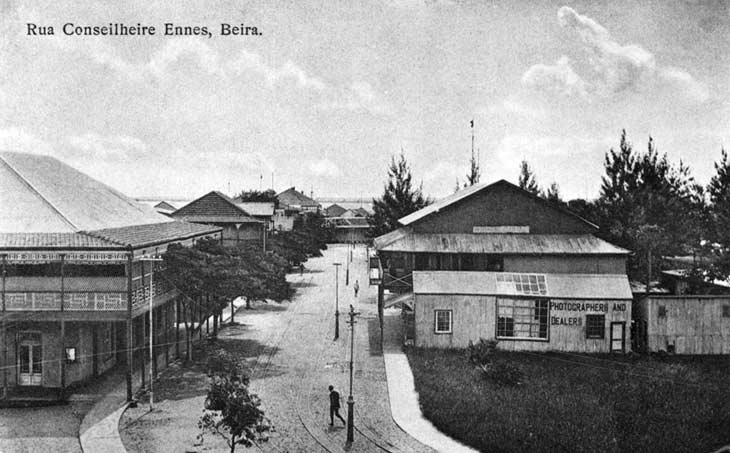The journey that Shankar completes in Chander Pahar is an epic one. Starting from Mombasa, in what is now Kenya, he travels through countries in Central Africa, South Africa, Namibia, Zimbabwe, and leaves for India from Beira, in what is now Mozambique.
There may have been longer and more difficult fictional journeys, but I can't recall them. In comparison, the Odyssey is but a short, albeit fraught trip, among the little islands in Greece.
Here's the full map (drawn by me, hence inaccurate and purely indicative) of this journey.
Beira was established in 1890 by the Portuguese and soon became the main port in the Portuguese-administered territory. The Portuguese built the port and a railway to Rhodesia, Portuguese families settled in the newly-founded locality and started to develop commercial activities. Before Mozambique's independence from Portugal, as a city of Portuguese Mozambique, Beira was noted for its well-equipped seaport, one of the major facilities of its kind in all East Africa, tourism, fishing and trade. The city prospered as a cosmopolitan port with different ethnic communities (Portuguese, Indian, Chinese, indigenous Africans) employed in administration, commerce, and industry. During the colonial era, a large English-speaking population was the result of being a favourite holiday destination for white Rhodesians.
I found this picture in Wikipedia - "View of Rua Conseleheira Ennes, Beira, Mozambique. Photograph of original postcard c1905, published by The Rhodesia Trading Co. Ltd., Beira", dated1905.
Perhaps Shankar travelled from Salisbury to Beira in this very train.
(Both these pictures are taken from Wikipedia and rights belong to their various owners).
You could buy my book in Flipkart.com, and other online book stores.
There may have been longer and more difficult fictional journeys, but I can't recall them. In comparison, the Odyssey is but a short, albeit fraught trip, among the little islands in Greece.
Here's the full map (drawn by me, hence inaccurate and purely indicative) of this journey.
Beira was established in 1890 by the Portuguese and soon became the main port in the Portuguese-administered territory. The Portuguese built the port and a railway to Rhodesia, Portuguese families settled in the newly-founded locality and started to develop commercial activities. Before Mozambique's independence from Portugal, as a city of Portuguese Mozambique, Beira was noted for its well-equipped seaport, one of the major facilities of its kind in all East Africa, tourism, fishing and trade. The city prospered as a cosmopolitan port with different ethnic communities (Portuguese, Indian, Chinese, indigenous Africans) employed in administration, commerce, and industry. During the colonial era, a large English-speaking population was the result of being a favourite holiday destination for white Rhodesians.
I found this picture in Wikipedia - "View of Rua Conseleheira Ennes, Beira, Mozambique. Photograph of original postcard c1905, published by The Rhodesia Trading Co. Ltd., Beira", dated1905.
Perhaps Shankar travelled from Salisbury to Beira in this very train.
(Both these pictures are taken from Wikipedia and rights belong to their various owners).
You could buy my book in Flipkart.com, and other online book stores.



